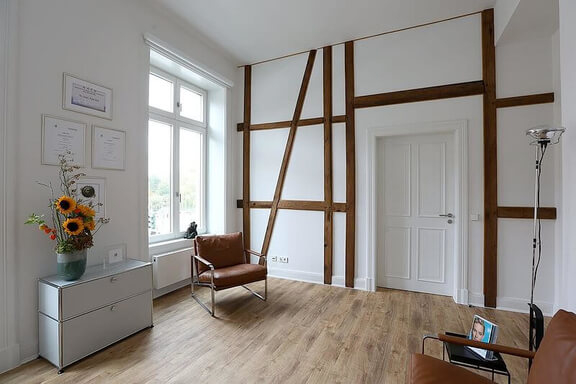Snoring - annoying for others, harmful to the snorer
Anyone who has ever had to (or has to) sleep next to a loud snorer knows what we’re talking about: Snoring is bothersome. But it’s not just annoying to the person lying beside the snorer - it’s also harmful to the snorer him- or herself. People who snore get less restful sleep, which means they are often tired during the day, cannot concentrate as well, are less resilient, and may be more easily irritated, even though they have slept for a sufficient number of hours. Snoring: for others it’s annoying, but for the snorer it is a burden and can even be harmful in the long term. Snoring affects your quality of life. Daytime fatigue and concentration problems, in particular, are issues that should make any snorer stop and think - both in the interest of his or her partner’s well-being, and in the interest of his or her own health.
Snoring is more than just a trifling offense: it can also be a health problem. Snorers who experience breathing pauses during sleep (also known as SAS - sleep apnea syndrome), in particular, should definitely seek medical consultation.
HEALTHY SLEEP
Sleeping is healthy. We need to sleep to be healthy and to stay healthy. We can even use sleep to become healthy - it’s no coincidence that people often refer to “sleeping it off”.
Healthy sleep alternates between dream stages and recovery stages. People need both: dream stages help them process the day’s experiences, while recovery stages help them recover from the pressures of the day.
People are not machines. Constant stress is not good for them. It endangers their health and ultimately makes them sick. This is why restful sleep is so important, which in turn is what makes treating snoring a priority.
SLEEP DISRUPTION
Anything that disturbs our sleep is harmful, whether it caused by external forces (e.g., noise) or internal ones (e.g., nasal breating problems, snoring or nighttime breathing pauses). Sleep disruptions weaken the body and can make us sick over the long term: circulatory disorders, metabolic disorders, hormonal imbalances, headaches, throat infections, etc.
CAUSES OF SNORING AND SLEEP APNEA
Respiratory disorders are divided up into obstructive and central disorders. Obstructive respiratory disorders are the result of the airway being blocked (e.g., constriction or instability), and can generally be treated by physical or surgical therapeutic means. Broadly and simply put, central respiratory disorders are the result of the brain’s breathing center being incorrectly regulated; such issues can not be treated surgically.
The most common respiratory issues are combined ones, i.e., both obstructive and central disorders in different proportions, which is why it is important to clarify the situation diagnostically in order to select an appropriate treatment approach. For this reason, snoring and sleep apnea should be examined and treated from an internal medical (and/or neurological) perspective as well as from an otolaryngological (and/or orthodontic / oral-surgical) one.
PALATE AND UVULA
Not only we relax when we sleep—our muscles do, too. This causes the throat to slacken and constrict. Sleeping on one’s back can even result in the throat region practically collapsing. Many snorers’ soft palates (or velums) and uvulas are elongated and slackened as well. Airflow across this passageway creates breathing noise: obstructive snoring.
Tightening the velum may be of good therapeutic benefit in such cases, possibly in combination with shortening the uvula. Besides the conventional surgical veloplasty options, we can now provide our patients with highly conservative and minimally invasive methods available as well.
At our practice in Hamburg, we primarily use what is known as the radiofrequency method, which can tighten the internal soft palate musculature without surgical incisions. With this method, the patient is placed under short-term anesthesia, and a fine probe is inserted into his or her palatal arch. Then we apply carefully metered radiofrequency waves to tighten the palate muscles. An automatic shut-off function within the device ensures that the tissue does not get overheated or damaged.
RESPIRATORY DISORDERS – NOSE AND NASAL PHARYNX
Impaired nasal breathing can cause snoring or sleep apnea, so snorers should definitely always have their noses checked. Causes may include, for example, respiration-impairing bending of the nasal septum (septal deviation), enlargement of the turbinates (turbinate hyperplasia), sinus disorders (sinusitis), disorders of the mucous membranes, polyps (polyposis nasi), allergies (e.g., hay fever), etc.
Many children experience enlargement of what are commonly known as “polyps” (adenoids, in medical terms), which impedes their breathing to the point that it causes them to snore. The snoring often stops if these adenoids are removed, or if they regress on their own immediately.
Occasionally, adults may also experience this narrowing of the nasopharynx, and it may cause them to snore as well. Such conditions should definitely be examined by an ENT specialist.
SNORING - TREATMENT OPTIONS
In many cases, snoring is caused by the slackening of the soft palate, sometimes in combination with an elongated uvula. Tightening the velum may be of therapeutic benefit in such cases, possibly in combination with shortening the uvula. Besides the conventional surgical veloplasty options (UVPP, or uvulo-velo-pharyngoplasty), there are now highly conservative and minimally invasive methods available as well.
In our practice in Hamburg, we primarily use what is called the radiofrequency method, which can tighten the internal soft palate musculature without surgical incisions. With this method, the patient is placed under short-term anesthesia, and a fine probe is inserted into his or her palatal arch. We apply carefully metered radiofrequency waves to tighten the palate muscles. An automatic shut-off function within the device ensures that the tissue does not get overheated or damaged.
Some snorers have slackening of the soft palate, elongation of the uvula and nasal breathing impairment all at the same time. Such cases can be treated by combining the radiofrequency method with nasal corrective surgery (e.g., septoplasty).
Contact
Dr. Axel Arlt
Practice community
Esplanade 31 / Ecke Stephansplatz
D - 20354 Hamburg
Phone: +49 (0)40 - 413 55 66 9
Mail: info@dr-axel-arlt.de


